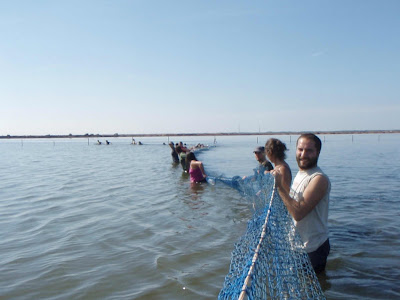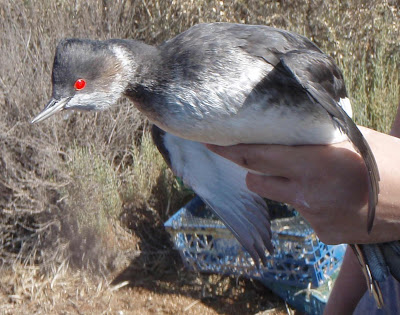Black-necked Grebe round-up
Every year, thousands of Black-necked Grebes migrate south from their breeding grounds in the Arctic tundra to moult and spend the winter in the south of Europe. There is a particular concentration that favours the salt pans (salins) near Huelva in Andalusia. They feed mainly on the larvae of aquatic insects.
Here, there is a long-term research study in which samples of the grebes are captured during the moulting period (when flying is weakest) for ringing and measurement. I was fortunate to be invited to participate in one of the capture events.
Here, there is a long-term research study in which samples of the grebes are captured during the moulting period (when flying is weakest) for ringing and measurement. I was fortunate to be invited to participate in one of the capture events.
 The salt pans are also the home of thousands of Greater Flamingos (this individual is flying from right to left)
The salt pans are also the home of thousands of Greater Flamingos (this individual is flying from right to left) The grebes are not web-footed (like ducks) but have these lobed feet as an adaptation for swimming and diving
The grebes are not web-footed (like ducks) but have these lobed feet as an adaptation for swimming and diving















10 Comments:
I was struck with their amazing feet! What a fun project, Maalie.
crikey! he looks like a wild australian bushranger!
But the net doesn't appear to have a 'roof'. How come they don't just fly away instead of staying in the corral?
The birds are in moult at that time and can only fly weakly. Their natural response is to escape from predatgors by diving and swimming away. We did lose a few that flew back over our heads.
ahhhhhhhh that makes sense...poor things...caught when they are most vulnerable ;-)
Poor things? We are doing them a favour! By studying their ecology we learn more about their environmental requirements and can then implement (or at least recommend) appropriate conservation measures :-)
I know..... the scientific part of me can appreciate that.....but the other part of me feels sorry for them, grabbed in their time of weakness. I think of the moulting penguins here in NZ who get people going too close....
The consolation is that there is food there in abundance. They soon fatten up.
What great work, though I wouldn't fancy wading in the water. The director looks quite a character.
Jim,
With global warming coming along, I am presently looking forward to donning my string vest and jumping into the Duddon's warm receiving waters ...
I have sent you a couple of emails in reply to yours about Beer at The Green. I wonder if your spam filter is, probably wisely, excluding my missives.
Jon of the Hill
Post a Comment
<< Home